“The Coming Forth of the Book of Mormon,” Ensign, Dec. 1983, 31
The Book of Mormon
The Coming Forth of the Book of Mormon
In a November 1841 meeting with the Council of the Twelve Apostles in Nauvoo, the Prophet Joseph Smith bore this memorable testimony of the Book of Mormon:
“I told the brethren that the Book of Mormon was the most correct of any book on earth, and the keystone of our religion, and a man would get nearer to God by abiding by its precepts, than by any other book.” (History of the Church, 4:461.) On an earlier occasion he had also said, “Take away the Book of Mormon and the revelations, and where is our religion? We have none.” (History of the Church, 2:52.)
The adult scripture reading assignment for the coming year is the Book of Mormon, which not only gives an account of early inhabitants of America, but also contains “the fulness of the gospel of Jesus Christ.” (D&C 20:9.) The following pages, prepared by the Ensign staff, present documents, artifacts, and photographs of people and places related to the coming forth of this new latter-day testimony of Jesus Christ. Some of the materials are familiar to Church members; some have generally been accessible only to scholars; and some have just recently come to light and are here published for the first time.

Palmyra

The Hill Cumorah

The Smith Farm

Hyrum Smith’s Box

Joseph Smith Farm Home in Harmony, Pennsylvania
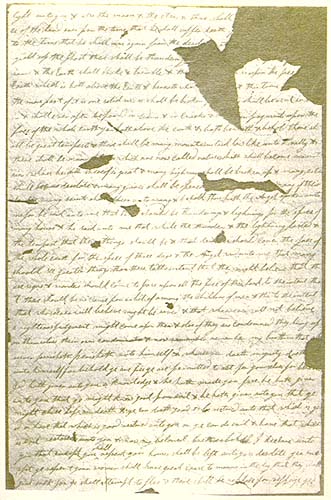
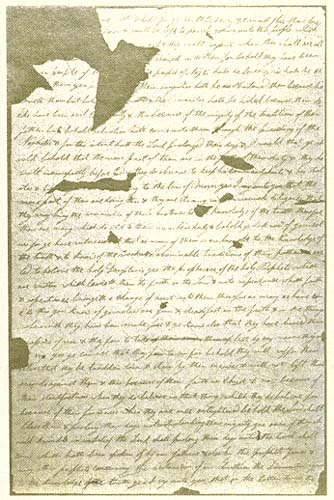
The Dictated Manuscript

Peter Whitmer Farm Home in Fayette, New York
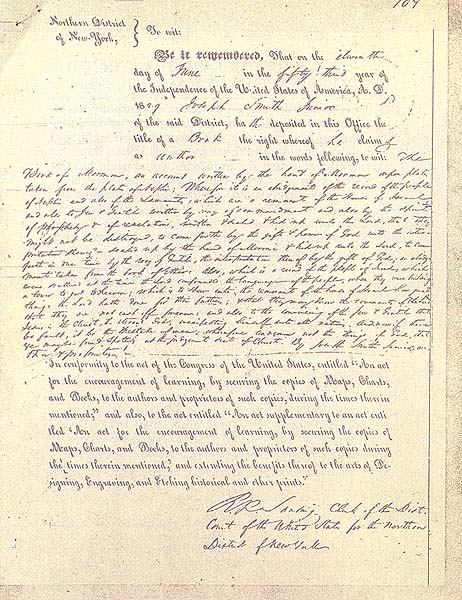
Copyright Document

The Grandin Building

John H. Gilbert Recounts the Printing Work

Printing Press

Pieces of Type Used in the Press

Agreement between Martin Harris and Joseph Smith, Sr.
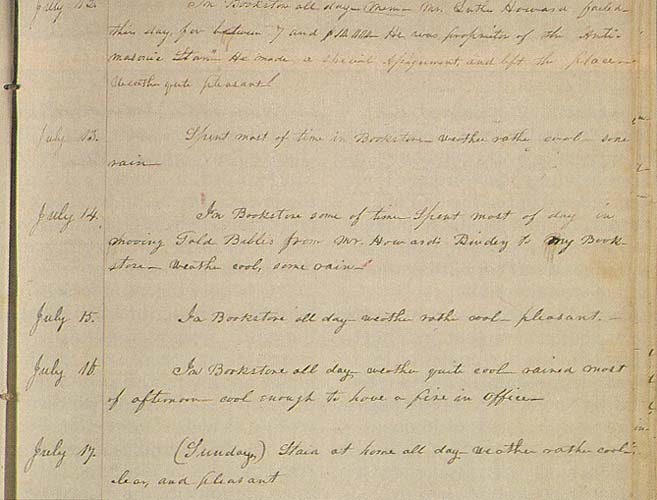
Grandin Journal Page
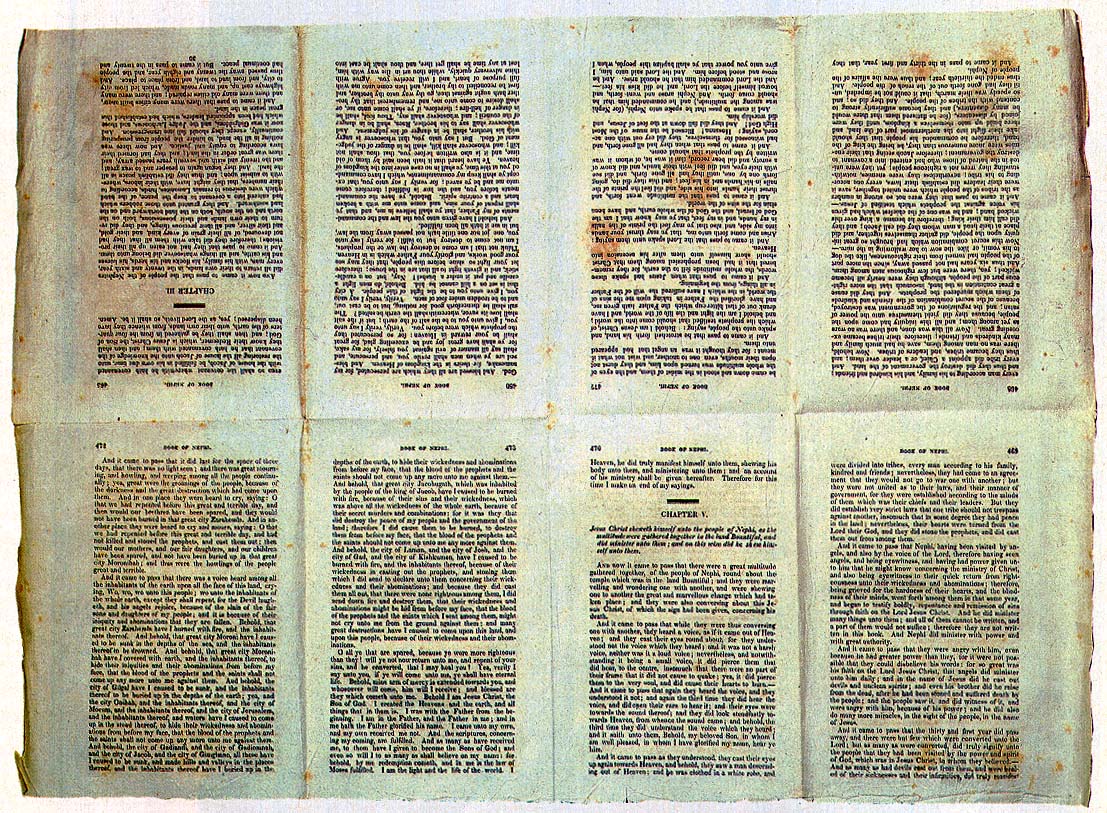
Uncut Sheet from the Book of Mormon

Oliver Cowdery Letter

The Message of the Book of Mormon Goes Forth
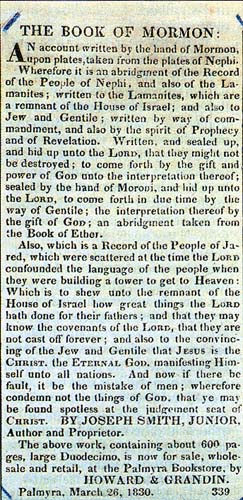
Advertisement for the Book of Mormon
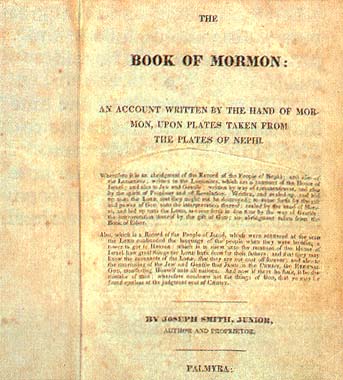

First Edition

Joseph Smith Handwritten Document
Painting by Lewis A. Ramsey
Photography by Public Communications Photo Services and by the Church Historical Department
A view of Palmyra, New York, about 1880, looking south toward Manchester. This artist’s view from a hill north of the village shows Palmyra as a thriving community fronting on the Erie Canal (foreground). The Smith farm lay south of Palmyra about two miles, in the area at the center of this picture, just on the horizon.
Of the Hill Cumorah, Joseph Smith wrote: “Convenient to the village of Manchester, Ontario county, New York, stands a hill of considerable size, and the most elevated of any in the neighborhood. On the west side of this hill, not far from the top, under a stone of considerable size, lay the plates, deposited in a stone box. … I looked in, and there indeed did I behold the plates, the Urim and Thummim, and the breastplate.” (JS—H 1:51–52.)
This photograph of the Hill Cumorah, looking south from the road leading from Palmyra to Manchester, was taken by George Edward Anderson in the 1920s.
This photograph, taken in the 1920s by George Edward Anderson, shows the area of the Smith farm south of Palmyra, with the Sacred Grove in the far background. The frame home that still stands on the property (in the grove of trees near the barn visible at center) was occupied by the Smiths after they moved from their original log home nearby. It was in the log home that, in the evening of 21 September 1823, the Angel Moroni appeared to seventeen-year-old Joseph Smith and told him of the existence of the Book of Mormon:
“He said there was a book deposited, written upon gold plates, giving an account of the former inhabitants of this continent, and the source from whence they sprang. He also said that the fulness of the everlasting Gospel was contained in it, as delivered by the Savior to the ancient inhabitants.” (JS—H 1:34.)
Joseph Smith took the plates from the Hill Cumorah on 22 September 1827 and began to study and translate characters from them with the aid of the Urim and Thummim. He was twenty-one at the time and had married Emma Hale earlier that year.
In describing the plates, the Prophet wrote: “These records were engraven on plates which had the appearance of gold, each plate was six inches wide and eight inches long, and not quite so thick as common tin. They were filled with engravings, in Egyptian characters, and bound together in a volume as the leaves of a book, with three rings running through the whole. The volume was something near six inches in thickness, a part of which was sealed. The characters on the unsealed part were small, and beautifully engraved. The whole book exhibited many marks of antiquity in its construction, and much skill in the art of engraving.” (History of the Church, 4:537.)
Joseph kept the plates for a time in this box, lent to him by his brother Hyrum. The box is in the form of a lap desk. It is thought to have originally belonged to Joseph’s eldest brother, Alvin, and may have contained drawing tools Alvin used for designing the family home he was building. The box has been passed down through the family of Hyrum Smith and is now in the possession of Elder Eldred G. Smith, Patriarch Emeritus to the Church.
According to the Prophet Joseph Smith, “No sooner was it known that I had [the plates], than the most strenuous exertions were used to get them from me.” These problems, plus “intolerable” persecution of his family, led Joseph and Emma to move to her father’s home in Harmony, Pennsylvania, where they were kindly received. Not long afterward, Joseph Smith purchased 13 1/2 acres of land near the Susquehanna River from his father-in-law, Isaac Hale, and he and Emma bought a partly finished house and moved it onto their newly acquired land. It was in this house on 12 April 1828, that Joseph began to dictate the translation of the Book of Mormon, with Martin Harris acting as scribe. By June 14 they had completed the 116 pages of the translation that were subsequently lost by Martin Harris. On 7 April 1829, Oliver Cowdery began work as Joseph’s scribe. Oliver wrote:
“These were days never to be forgotten—to sit under the sound of a voice dictated by the inspiration of heaven, awakened the utmost gratitude of this bosom. Day after day I continued, uninterrupted, to write from his mouth, as he translated, with the Urim and Thummim, or, as the Nephites would have said ‘Interpreters,’ the history, or record, called ‘The Book of Mormon.’” (Messenger and Advocate, 1:14.)
This photograph shows the home Joseph and Emma lived in before it was destroyed by fire in 1919. The center section of the building is the original home; the two large sections on each end were added by subsequent owners sometime after Joseph and Emma finally left Harmony.
At present, fewer than 75 leaves of the manuscript dictated to Oliver Cowdery are known to exist, accounting for less than 150 pages of the printed text. The extant pages contain text from the books of 1 and 2 Nephi, Alma, and Helaman. The pages from Nephi were written on 6 5/8″ by 16 1/2″ paper, while the bulk of the manuscript pages were on 8″ by 13″ paper.
This dictated manuscript was placed in the cornerstone of the Nauvoo House on 2 October 1841, where it remained until 1882. When the manuscript was removed, it was found that water had seeped in and destroyed the majority of the pages, especially those farther down in the stack. For this reason, most of the extant pages are from the earlier part of the manuscript; in fact, no pages are known to have survived from the books beyond Helaman. Because of the water damage, the ink is much faded on the existing pages. The paper was lined originally, but the lining has faded entirely.
The two manuscript pages seen on page 36 are from one leaf of the dictated manuscript containing 1 Nephi 7:17 through 8:27. In it is found part of Lehi’s vision of the tree of life.
Two additional pages from the dictated manuscript appear on page 37 and at right. They are from a recently discovered leaf containing the text of Helaman 14:20 through 15:12—part of Samuel the Lamanite’s prophecy of the tempests, upheavals, and darkness that would cover the earth after the crucifixion of Christ. No text farther along in the original manuscript is known to exist. This leaf is in a remarkable state of preservation, considering that it was positioned low in the water-damaged manuscript.
Antagonism began to mount in Harmony during May of 1829. Early the next month, David Whitmer arrived with a wagon and moved Joseph Smith and Oliver Cowdery to the home of his father, Peter Whitmer, where the translation could again be carried on in favorable circumstances. Here the translation was completed, and in the woods nearby an angel showed the plates to the Three Witnesses: Martin Harris, David Whitmer, and Oliver Cowdery. Here, too, the Church was organized on Tuesday, 6 April 1830.
The log home shown here is a replica built on the same site as the original farmhouse. The reconstruction of this dwelling was based on details from historical documents and careful archaeological investigation.
Two weeks before the translation was completed, Joseph Smith went to Palmyra and obtained the copyright for the Book of Mormon. The copyright form is dated June 11, 1829. In describing the book, the Prophet employed the words found on the title page of the Book of Mormon. According to the History of the Church (1:71), Joseph Smith declared that the title page was “a literal translation, taken from the very last leaf” of the plates. By law, a copyright could be granted only to the author and owner of a published work; therefore, Joseph Smith is listed as “author and proprietor.” In subsequent editions of the Book of Mormon, the more correct phrase “Translated by Joseph Smith, Jun.” has appeared on the title page.
At left is a view of the front of the Grandin building in Palmyra (in green trim). The print shop occupied the westernmost end of the upper story, marked by the three windows at the building’s left. The second story contained a book bindery, and Grandin’s bookstore and circulating library was located on the street level.
Egbert Grandin
Egbert B. Grandin, pictured here in an 1843 portrait by Alonzo Parks, was three months younger than the Prophet Joseph Smith and died in April 1845, less than a year after Joseph met his death in Illinois. Grandin bought his Palmyra printing business and bookstore in 1827 from John H. Gilbert, the printer who, as Grandin’s employee, set type for the Book of Mormon. By 1833 Grandin had left the printing business; he worked at a variety of occupations until his death.
John H. Gilbert, Jr., who was a typesetter and pressman for the first printing of the Book of Mormon, wrote the following statement in Palmyra in 1892, when he was 90 years old. In it, he reports many interesting details of the printing work, including the fact that it was he who “punctuated” the Book of Mormon:
“In the forepart of June 1829, Mr. E. B. Grandin, the printer of the ‘Wayne Sentinel,’ came to me and said he wanted I should assist him in estimating the cost of printing 5000 copies of a book that Martin Harris wanted to get printed. …
“A few pages of the manuscript were submitted as a specimen of the whole, and it was said there would be about 500 pages.
“The size of the page was agreed upon, and an estimate … that a page of manuscript would make more than a page of printed matter, which proved to be correct.
“The contract was to print and bind with leather, 5000 copies for $3,000. Mr. Grandin got a new font of Small Pica, on which the body of the work was printed. When the printer was ready to commence work, Harris was notified, and Hyrum Smith brought the first installment of manuscript, of 24 pages, closely written on common foolscap paper—he had it under his vest, and vest and coat closely buttoned over it. At night Smith came and got the manuscript, and with the same precaution carried it away. The next morning with the same watchfulness, he brought it again, and at night took it away. This was kept up for several days. The title page was first set up, and after proof was read and corrected, several copies were printed for Harris and his friends. On the second day—Harris and Smith being in the office—I called their attention to a grammatical error, and asked whether I should correct it? Harris consulted with Smith a short time, and turned to me and said: ‘The Old Testament is ungrammatical, set it as it is written.’
“After working a few days, I said to Smith on his handing me the manuscript in the morning; ‘Mr. Smith, if you would leave this manuscript with me, I would take it home with me at night and read and punctuate it.’ His reply was, ‘We are commanded not to leave it.’ A few mornings after this, when Smith handed me the manuscript, he said to me:—‘If you will give your word that this manuscript shall be returned to us when you get through with it, I will leave it with you.’ I assured Smith that it should be returned all right when I got through with it. For two or three nights I took it home with me and read it, and punctuated it with a lead pencil. …
“Martin Harris, Hyrum Smith and Oliver Cowdery were very frequent visitors to the office during the printing of the Mormon Bible. The manuscript was supposed to be in the handwriting of Cowdery. Every Chapter, if I remember correctly, was one solid paragraph, without a punctuation mark, from beginning to end.
“Names of persons and places were generally capitalized, but sentences had no end. The character or short &, was used almost invariably where the word and, occurred, except at the end of a chapter. I punctuated it to make it read as I supposed the Author intended, and but very little punctuation was altered in proofreading. The Bible was printed 16 pages at a time, so that one sheet of paper made two copies of 16 pages each, requiring 2500 sheets of paper for each form of 16 pages. There were 37 forms of 16 pages each,—570 pages in all.
“The work was commenced in August 1829, and finished in March 1830,—seven months. Mr. J. H. Bortles and myself done the press work until December taking nearly three days to each form.
“In December Mr. Grandin hired a journeyman pressman, Thomas McAuley, or ‘Whistling Tom,’ as he was called in the office, and he and Bortles did the balance of the press-work. The Bible was printed on a ‘Smith’ Press, single pull. …
“The printing was done in the third story of the west end of ‘Exchange Row,’ and the binding by Mr. Howard, in the second story the lower story being used as a book store, by Mr. Grandin, and now—1892—by Mr. M. Story as a dry-goods store.
“Cowdery held and looked over the manuscript when most of the proofs were read. Martin Harris once or twice, and Hyrum Smith once, Grandin supposing these men could read their own writing as well, if not better, than any one else; and if there are any discrepancies between the Palmyra edition and the manuscript these men should be held responsible.
“Joseph Smith, Jr. had nothing to do whatever with the printing or furnishing copy for the printers, being but once in the office during the printing of the Bible, and then not over 15 or 20 minutes.” (Wilford C. Wood, Joseph Smith Begins His Work, Salt Lake City: Wilford C. Wood, 1958, introductory pages.)
This is the press used in printing the Book of Mormon. Grandin probably acquired the press in March 1829, about six months before he began work on the Book of Mormon. The press, a single-pull Smith press, was purchased by the Church in 1906. Setting type and printing was laborious hand work. Each character had to be picked out of the type case, set up by hand, inked form by form, and the sheets hand printed, sixteen pages at a time. It is estimated that the printers worked eleven hours a day, six days a week, for more than seven months to print the almost six hundred pages of the Book of Mormon’s 5,000 copies.
These are a few of the three hundred pieces of type found between the floorboards in the Grandin shop during on-site studies in the printing office. To typeset the Book of Mormon, Grandin sent to Albany for a new font of “Small Pica” type to supplement his regular equipment. Some pieces of type found in the shop appear to be from the same font used on the title page of the Book of Mormon.
It was Martin Harris who provided the financial backing for the publication of the Book of Mormon, pledging his farm as security for the $3,000 obligation. In this agreement (which, incidentally, points out the role of the Prophet’s father, Joseph Smith, Sr., in the publication of the Book of Mormon), the elder Smith agrees that the first profits from the sale of the book were to go toward the payment of the printer, thus relieving Martin Harris of the full burden of payment: “I hereby agree that Martin Harris shall have an equal privilege with me and my friends of selling the Book of Mormon of the Edition now printing by Egbert B. Grandin until enough of them shall be sold to pay for the printing of the same or until such times as the said Grandin shall be paid for the printing the aforesaid books or copies.” Dated January 16, 1830, in Manchester, New York, the document was signed by Joseph Smith, Sr., and witnessed by Oliver Cowdery. Ultimately, however, 151 acres of Martin’s farm were sold to meet the printing expenses.
This volume of E. B. Grandin’s journal began in January 1831, nine months after he completed the Book of Mormon. In his entry for 14 July 1831, he records that he “spent most of day in moving Gold Bibles from Mr. Howard’s Bindery to my Bookstore.”
This sheet is from the complete set of first uncut sheets of the first edition of the Book of Mormon. This set of uncut sheets belonged to John H. Gilbert, Book of Mormon typesetter, who at a later period gave them to a banker as collateral for a loan. They were kept in the banker’s family and are now part of the Wilford Wood Collection. The pages on this sheet are arranged in such a way that when the sheet is folded three times, the pages are in numerical order; and this “form,” when cut and bound together with the thirty-six other printed forms, completed a book of nearly 600 pages.
On the third bottom page from the left begins “Chapter V” of the “Book of Nephi”—chapter 11 of 3 Nephi in current editions. At the bottom of this page (which continues upside-down on the page just above), we read of the paramount event in the entire Book of Mormon:
“And it came to pass as they understood, they cast their eyes up again towards Heaven, and behold, they saw a man descending out of Heaven: and he was clothed in a white robe, and he came down and stood in the midst of them. … And it came to pass that he stretched forth his hand, and spake unto the people, saying: Behold I am Jesus Christ, of which the prophets testified that should come into the world.” [3 Ne. 11]
During most of the several months when the Book of Mormon was being printed in Palmyra, Joseph and Emma remained on their farm in Harmony, Pennsylvania. Oliver Cowdery was occupied daily making a printer’s copy of the original manuscript. At left are two portions of a letter to Joseph Smith in Harmony, dated November 6, 1829, in which Oliver rejoices in the mercies of God and in the atonement of Christ. He also mentioned that “the printing goes rather slow yet as the type founder has been sick but we expect that the type will be in and Mr. Grandin still thinks he will finish printing by the first of febuary.” In a postscript he adds: “I have just got to Alma commandment to his son in coppying the manuscrip”—that is, to Alma 36.
One of five pages from John Taylor’s journal, written in April 1845, recounting Solomon Chamberlain’s early missionary journeys with some of the printed pages of the Book of Mormon.
It has been widely thought that the first missionary for the newly restored church was Samuel H. Smith, a younger brother of the Prophet Joseph Smith. His mother reports that Samuel left home with a knapsack full of copies of the recently published Book of Mormon on 30 June 1830. This missionary journey is traditionally referred to as the one which brought the Book of Mormon into the hands of Brigham Young and eventually resulted in his conversion.
Though sources for the earliest periods of Church history are scanty, there is now evidence that others preceded Samuel into the field following the organization of the Church, to bear testimony of the Book of Mormon and the restored gospel. Members of the Smith and Whitmer families, besides others, appear to have been carrying the word to neighbors and strangers alike in Ontario, Wayne, Seneca, and Livingston counties, while others were going farther afield to preach. Oliver Cowdery, for example, described as the “Apostle to the Nephites” in the Palmyra Reflector of June 1, 1830, was reported to have departed Palmyra by Erie Canal packet boat “with a load of Gold Bibles” to “declare the truth … in … principle cities of the Union.”
But missionary work had commenced even before the Church’s organization, as neighbors and friends of the first adherents of the restored gospel were introduced to the Book of Mormon and told of sacred experiences. Some of the first converts, such as Thomas B. Marsh and Solomon Chamberlain, took copies of pages of the yet unpublished Book of Mormon with them on preaching tours. Solomon Chamberlain’s contact with Brigham and Phineas Young prior to the Church’s organization is likely the earliest documented introduction these two future leaders of the Church had to this new book of scripture.
Solomon Chamberlain, a native of Connecticut, was forty-one years old in 1829 when a spiritual manifestation led him to the Smith home near Palmyra. At that time, the printing of the Book of Mormon had just begun. The following account of Chamberlain’s introduction to the Book of Mormon, and his subsequent preaching journey with printed pages of the book, is taken from an April 1845 entry in President John Taylor’s journal. Chamberlain was one of the original pioneers who entered the Salt Lake Valley in 1847; he died a faithful member of the Church in 1862, at age seventy-three.
“Speaking a few days since with a man of the name of Solomon Chamberlin, he related some particulars that I thought interesting concerning the manner that he was brought to obey the truth; and concerning the early rise of the Church as he was one of the first members. I will relate it in his own words:
“‘[In the year 1816] I felt very anxious to know whether there were any people on the earth whose principles were right in all things; for I was tired of all orders unless they had the true principles of God: I believed we might receive revelation for ourselves: I believed if we lacked wisdom and humbled ourselves before God in mighty prayer, and asked in sincerity he would give us; I did so with all my heart, and he answered my prayer. The Lord revealed to me in a vision of the night an angel, I thought if I could ask him, he could tell me all I wanted to know. I accordingly asked him if we were right. He said not one of us were right, and that there were no people on earth that were right; but that the Lord would in his own due time raise up a church, different from all others, and he would give power and authority as in the days of Christ; and he would carry it through and it should never be confounded; and that I should live to see the day, and know the work when it came forth; and that great persecution should follow, and much more after this he told me. …
“‘Somewhere about the time that Joseph Smith found the record of the Book of Mormon, I began to feel as though the time was nearly come, that had been made known to me by the angel. I made some inquiries through the country if there was any strange work of God, such as had not been on the earth since the days of Christ. I was then living on the Erie Canal forty miles below Rochester; I had occasion to go on a visit to Canada. I took boat for Lockport; when the boat came to Palmyra, I felt as if some genie or good spirit told me to leave the boat, and go or travel a south course; I did so for about three miles. (I had not yet heard of the gold bible so called at that time, nor any of the Smith family, I was an entire stranger in that part of the country.) Here my guide told me I must put up for the night; and I heard of the Smiths and the gold bible for the first time. I was now within half a mile of Joseph Smith’s father’s house where my guide had brought me.—In the morning the woman asked me if I had heard of the gold bible. I told her I had not; and there was something began on the top of my head and went to my toes like electricity: I said to myself I shall soon find why I have been led to this place in this singular manner. It only being about half a mile from there across lots to Father Smith’s, I soon arrived at the house and found Hyrum walking the floor; as I entered the room, I said peace be to this house; he looked at me and said “I hope it will be peace.” I then said is there any one here that believes in visions and revelations. He said yes, we are a visionary house. I then said I will give you one of my pamphlets, (which was visionary and of my own composition) and if you are a visionary house, I wish you would make known some of your discoveries, I think I can bear them. They then began to make known to me, that they had obtained a gold record, and had just finished translating it. Here I staid, and they instructed me in the manuscripts of the Book of Mormon; after I had been there two days, I went with Hyrum and some others to Palmyra printing office, where they began to print the Book of Mormon; and as soon as they had printed sixty-four pages I took them and started for Canada; and I preached to all that I saw, high and low, rich and poor, and all that I knew concerning the work. I had but few to oppose, they had not made up their minds, and they knew not what to think of it. I did not see anyone in travelling six or seven hundred miles that had ever heard of the gold bible so called. When I returned from Canada, I went to Massachusetts, and preached the work to all both great and small; and told them to prepare for the great work of God, that was now coming forth, that would never be confounded nor be brought down; but would stand for ever and be like unto the apostolic church. As soon as the books were printed, I took eight or ten of them, and started off to sell and to preach; for you could not sell one without a great deal of preaching. I labored hard for eight days and sold one book on which I made twenty-five cents, and bore my own expenses. I carried them to the reform Methodist Conference, there I found Phineas and Brigham Young with whom I had been acquainted before. I thought I could soon convince the whole conference of the truth of the Book of Mormon, but I soon found my mistake, for after laboring with them for two days, they rejected me. Phineas and Brigham Young used me well. I returned home and on the way preached it to the Tree Hill Baptist Church, and they received it, and soon after the Church was established a number of them were baptized. Soon after this I was baptized by Joseph Smith in the waters of Seneca Lake, and emigrated to Ohio.’”
Dated March 26, 1830, this advertisement in the Wayne County Sentinel is the first published notice of the availability of the Book of Mormon. The ad duplicates the information on the title page of the Book of Mormon and adds the following: “The above work, containing about 600 pages, large Duodecimo, is now for sale, wholesale and retail, at the Palmyra Bookstore, by HOWARD & GRANDIN.”
The title page and an interior page of a first edition copy of the Book of Mormon. Note that the text is in paragraph form. The text was not divided into chapters and numbered verses until 1879, and was first issued in double-column pages in 1920. Note also the difference in chapter divisions. The text on this page numbered “Chapter VII” of the book of Alma, is actually the beginning of Alma 9 in today’s editions.
The Prophet Joseph Smith’s own testimony of the Book of Mormon was sealed with his martyrdom on 27 June 1844. He was thirty-eight years old. Section 135 of the Doctrine and Covenants (D&C 135:3) points out the ultimate significance of his role in restoring the Book of Mormon to mankind: “In the short space of twenty years, he … brought forth the Book of Mormon, which he translated by the gift and power of God, and … sent the fulness of the everlasting gospel, which it contained, to the four quarters of the earth.” (Italics added.)
In the document, written in Nauvoo in Joseph Smith’s own hand on 24 February 1842, the Prophet authorized Ebenezer Robinson to use the printing plates and copyright to print 1,500 copies of the Book of Mormon.